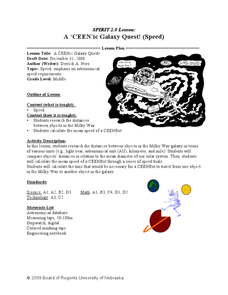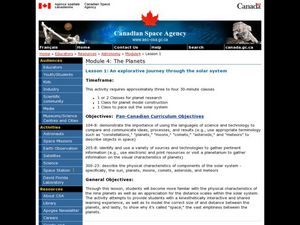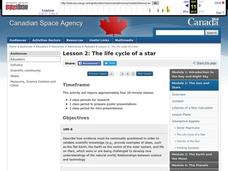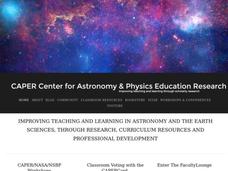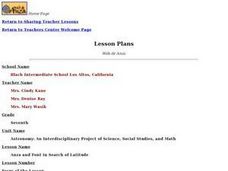NASA
Tools of the Trade
Did you know every state in the U.S. has at least one observatory? During the activity, scholars research the cost of building and maintaining an observatory. They must present their information in a proposal to build a new observatory,...
Space Awareness
Meet Our Neighbors: Sun
The sun isn't just a ball of yellow! Young scientists learn about the features of the sun using a hands-on modeling activity. They build models of the sun using common household items to represent sunspots, solar prominence, and the...
Curated OER
Solar Surfing
Students explore sources of solar astronomy. They use the internet to identify web pages associated with solar observatories, astronomical organizations, and educational sights associated with both. Students identify the type of...
National Center for Case Study Teaching in Science
The Zarkah Stone
Astronomy stars read the account of the Zarkah meteorite that struck thickly populated Park Forest, Chicago in 2003. In doing so, they differentiate between meteors, meteorites, and meteoroids. They will also be able to explain...
Curated OER
Interactive Online Light Activity
Students participate in an online interactive activity in which they discover types of light, wavelengths of light, and how astronomers use different wavelengths. Activity includes links for other activities and lab activities including...
Curated OER
Quiz: Name the Constellation
In this science worksheet, 3rd graders will focus on the stars and their constellations. Students will respond to ten questions, naming the constellation that is described in each.
Curated OER
Planetary Terrain
Students research the unique features of their assigned planet. In this astronomy lesson, students organize their findings and present it to class. They recreate planetary terrain and use CEENBoT to drive over it.
Curated OER
A CEENic Galaxy Quest!
Young scholars research the distances between objects in the Milky Way. In this astronomy lesson, students calculate the time it would take for a robot to travel from Milky Way object to another. They create a travel package for...
Curated OER
Science: Planet Sizes
Pupils compare planet sizes using class members holding fruit to represent the planets. They arrange the nine students in planetary order and compare and contrast the planets. Working in groups, pupils color and decorate planet cutouts.
Curated OER
Meteorites
Students model how meteors fall to the surface of planets. In this space science lesson, students identify different types of meteorites using an interactive online website. They investigate the relationship between a meteorite's size...
Curated OER
Solar System and Planets
Students identify the main components of the solar system. In this earth science lesson, students order the planets according to their distances from the Sun. They differentiate planets from dwarf planets.
Curated OER
An Explorative Journey Through the Solar System
Students explore space science by creating a planetary model in class. In this solar system lesson, students identify the many planets and moons that make up the solar system and decide on one entity in which to research. Students create...
Curated OER
The Life Cycle of a Star
Students investigate the life cycle of a star and make conclusions based on evidence, research, and observation. In this lesson on space and scientific investigation, students describe the relationships between science and...
Curated OER
Canadian Astronauts and Astronomers
Students research the web for Canadian nationals such as Marc Garneau, Roberta Bandar and Chris Hadfield who have contributed to science and technology. In this Astronauts and astronomers instructional activity, students work in groups...
Curated OER
Astronomy with a Stick
Students describe the movement of the Earth as it relates to the sun and
formulate a hypothesis for the movement and the changing length of the shadow. They express the relationship between the sun and the Earth and how that causes the...
Curated OER
Constellations
Fifth graders create their own constellations using pin holes and black paper. In this space science lesson, 5th graders write a story about their constellation. They share their project with the class.
Curated OER
Seasonal CEENBoT
Students simulate the Earth's revolution around the sun using CEENBoT. In this earth science lesson students calculate the Earth's distance in AU and it's speed of revolution. They explain how the Earth's movement cause seasonal variation.
Space Awareness
Model of a Black Hole
Even light cannot leave the force of a black hole! Learners use a model to explore the gravitational force of a black hole. An elastic bandage and heavy ball serve to create the hole, while marbles become the victims of its strong force.
Curated OER
The Expanding Universe
Students explore the expanding universe. In this science lesson plan, students use balloons to model the expansion of the universe. Students take measurements of the balloon expansion and answer questions directed to develop...
Curated OER
Chandra X-Ray Observatory
Learners tour Chandra's top galactic X-ray images. In this Chandra X-Ray Observatory instructional activity, students play games and complete puzzles based on the Chandra Mission and X-Ray Astronomy. Learners listen to pod casts,...
Curated OER
Timeline of Technology
Students choose an aspect of Astronomy to research. In this lesson on technology, students make a timeline of notable events in the development of astronomy and aerospace technology.
Curated OER
Astrology: Fact Or Fiction?
High schoolers investigate the concept of astrology and how it evolved from history. They use the Zodiac in order to find the location of constellations in the night sky. The differences between astrology and astronomy are compared and...
Curated OER
Anza and Font in Search of Latitude
This is an integrated activity that incorporates Social Studies, Science, and Mathematics. In Social Studies, 7th graders complete an online interview and complete an online worksheet about latitude of sites on the Anza trail. In Science...
Curated OER
The 'Solar' System Past and Present
Students identify cardinal and intermediate directions, recognize that models changes due to new or improved observations and technology, identify the major characteristics of the planets including their positions in the solar system,...
Other popular searches
- Astronomy and Space Science
- Space Science Astronomy
- Science Astronomy Stars
- Earth Science Astronomy
- Science Astronomy Graphing
- Life Science Astronomy
- "Astronomy and Space Science







